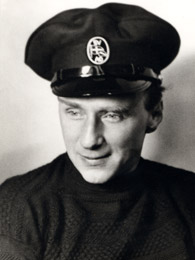Hans Leip facts for kids
Quick facts for kids
|
|
|---|---|

Hans Leip in uniform
|
|
| Born | Hans Leip 22 September, 1893 Hamburg, German Empire |
| Died | 6 June, 1983 Fruthwilen, Switzerland |
Hans Leip was a German writer, poet, and playwright. He lived from 1893 to 1983. He is most famous for writing the words to the popular song "Lili Marleen."
Leip was born in Hamburg, Germany. His father used to be a sailor and worked at the port. Hans went to school in Hamburg. In 1914, he became a teacher in a part of Hamburg called Rothenburgsort.
In 1915, he joined the German army. He trained in Berlin and then served as a soldier. He fought in World War I on the Eastern front and in the Carpathians. In 1917, he was hurt and left the army because of his injuries.
Hans Leip's Creative Journey
Hans Leip first wanted to be an artist. Later, he decided to focus on writing. Even so, he often drew pictures for his own books.
In the 1920s, Leip traveled a lot. He visited exciting cities like Paris, London, Algiers, and New York City. These trips likely gave him many ideas for his stories.
His first big success as a writer was with his novel Godekes Knecht. This book won an award from a newspaper called Kölnische Zeitung. Before World War II, his novels sold very well. He also wrote plays, short stories, and poems. Besides writing, he was also a painter and a sculptor.
The Story of "Lili Marleen"
Hans Leip wrote the words for "Lili Marleen" during World War I. He was serving in the army at the time. The poem was first called "Das Mädchen unter der Laterne." This means "The Girl under the Lantern" in German.
People say he combined the name of his girlfriend with the name of a nurse. Later, in 1937, the poem was published. It was called "Das Lied eines jungen Soldaten auf der Wacht." This means "The Song of a Young Soldier on Watch." Leip added two more verses to the poem at this time.
In 1938, Norbert Schultze wrote music for the poem. An English version was later written by Tommie Connor. The song was recorded by Lale Andersen in 1939. It became a huge hit all over the world. Many people loved it, and it was translated into many languages.
A Special Stamp
In 1993, Germany honored Hans Leip. This was 100 years after he was born. They released a special postage stamp with his image. The stamp showed an engraving that Hans Leip himself had created. He called this artwork "Tuledu Bridge."

